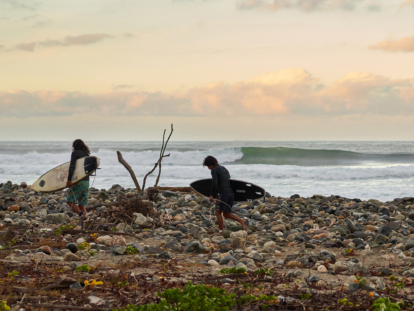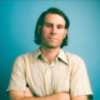Point Break Medicine
An exchange of waves and Indigenous cultural practices on the Pacific coast of Mexico.
All photos by Scott Soens
It’s midmorning and I’m standing under a palapa built on a thin threshold between cobblestone beach and Mexico’s dense Michoacán jungle. Out on the water, I see David, a local Nahua ripper, stand up on a head-high left and crouch through a deep bottom turn before belting the lip and sending its remnants skyward. Right behind him comes Reg Macarro, who leans into a lengthy frontside carve, the fingers of his leading hand grazing the water with Curren-esque grace. Seeing these two together like this, hooting for each other’s waves, Marc Chavez tells me later, is why he started this week-long Surf and Food as Medicine Retreat hosted by Native Like Water, an intertribal youth program and nonprofit based out of San Diego, California.
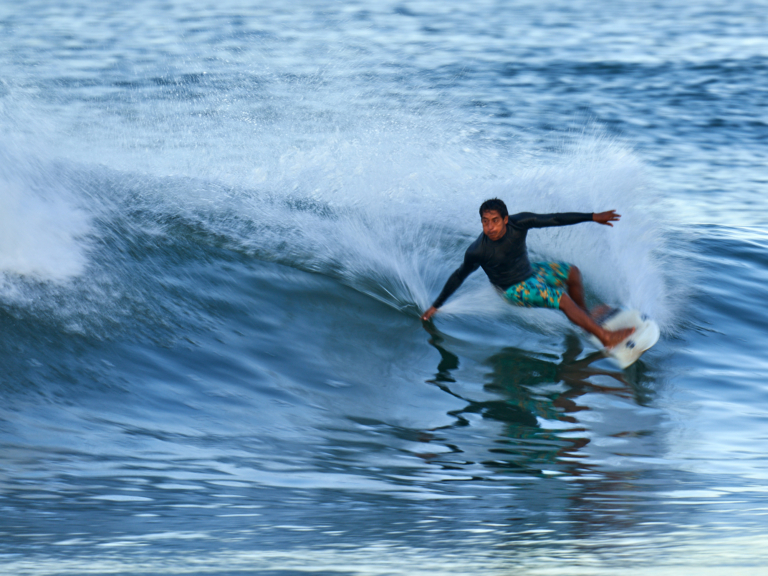
David’s an Indigenous Nahua surfer from the area and one of the hardest rippers around. He built a storage shed and palapa on the point and regularly hosts friends to surf and cook fresh-caught fish.
Marc is 51 years old, but you’d never guess it when first meeting him. He’s tall and fit with shoulder-length hair streaked by just a few grey strands, and his penchant for starting sentences with “bro” makes him seem like an overgrown grom at times. But when talking about things that aren’t waves—like the legacy of colonization and his hopes for Indigenous youth—he’s an old soul, deeply thoughtful and unabashedly vulnerable.
“Almost 500 years ago, Juan Rodríguez Cabrillo sailed from this part of Mexico to Southern California on a mission of colonization that harmed Native people,” Marc explains. “Today, we’re building a different kind of relationship between these two places and the Native people.” David’s Nahua family has lived on this coast since time immemorial; Reg is a 16-year-old Payómkawichum and Ojibwe surfer from Temecula, California. “These are two Indigenous nations connecting in a way that’s joyful,” Marc says.
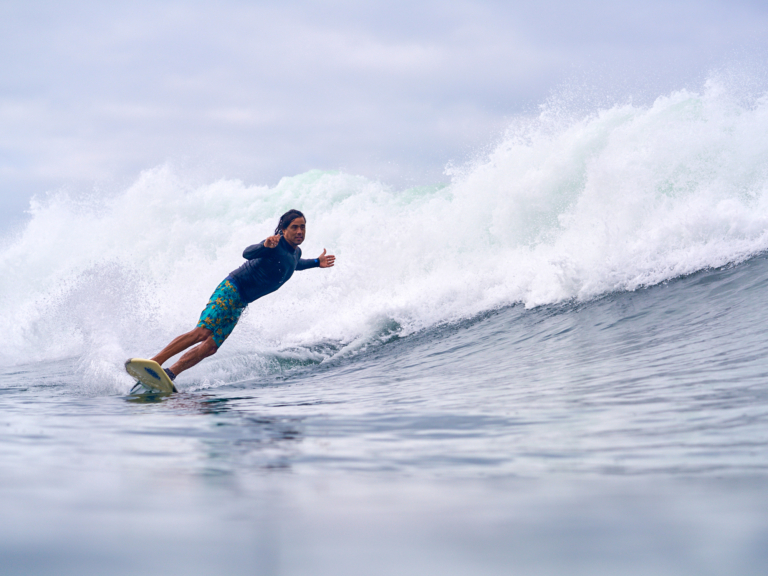
Marc styles off the bottom of a playful lefthander.
For the past few days, we’ve been staying in a sleepy beach town on the Michoacán coast, surfing the punchy beachbreak right in front of our hotel or driving to an idyllic point—a slightly soft, Lower Trestles–like left that caters to beginner and advanced surfers alike. Off the waves, we’ve been eating delicious vegetarian and seafood meals prepared by a visiting chef, Carolina. She runs Gaia Bowls in Nayarit and specializes in creating simple yet immensely flavorful meals from locally grown ingredients. It’s all part of this Surf and Food as Medicine Retreat.
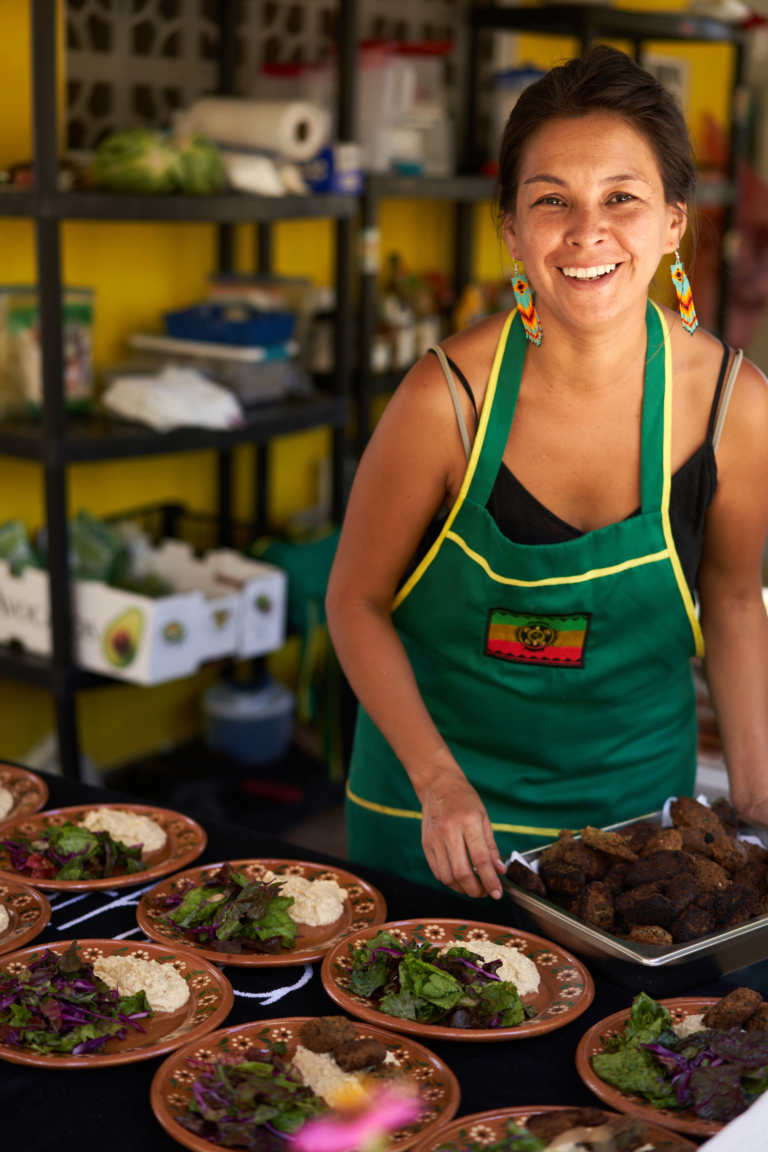
Carolina of Gaia Bowls provided all the meals for the group. Like this falafel, everything was healthy and delicious.
For more than 20 years, Native Like Water has sought to rebuild the connection between Indigenous youth and the ocean through education, mentorship and surfing. Every year, the organization’s fellowship program brings Indigenous teens and young adults from across North America together in California for a wide-ranging curriculum that has included a guided tour of Scripps Institution of Oceanography with a climate scientist and a workshop on building traditional tule boats with a Kumeyaay Elder followed by a sunset surf session. For Marc, this coastal emphasis is especially significant for Indigenous youth whose ancestors lived and recreated on the coast for thousands of years before being pushed into inland reservations by the United States government. But the Surf and Food as Medicine Retreat is something different—a little less academic in the traditional sense and a lot more personal to Marc.
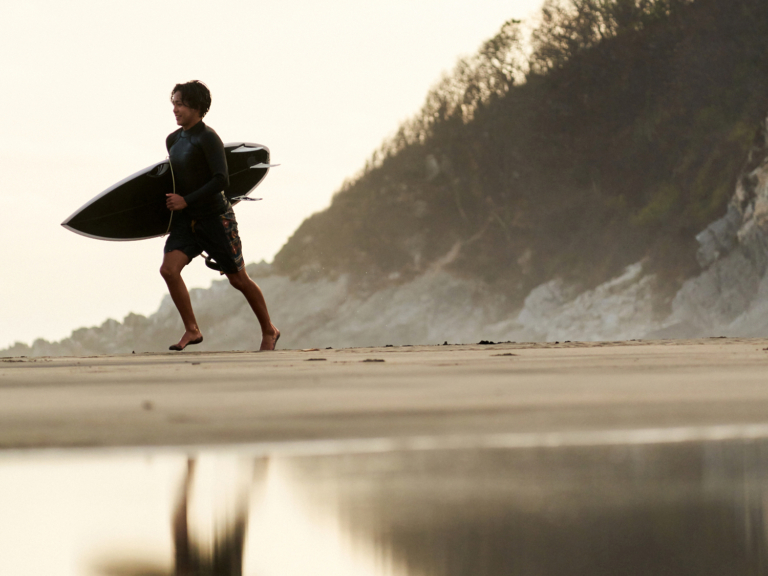
Reg runs up the beach after surfing a funky right reef before getting in the car to look for a better peak down the beach.
Marc grew up in the San Gabriel Valley in the 1980s, when gang and police violence were common in the area. “I got jumped, stabbed, beat over the head,” Marc says. “I almost died a few times.” The beach was 45 minutes away, but when he learned to surf, that’s all he wanted to do. In community college, he studied the history of surfing for a project, and for the first time became aware of surfing’s origins as an Indigenous cultural practice.
Marc is also a descendent of the Nahua people, who are indigenous to Mexico and Central America. He had always known that his mother was born in the inland city of Colima, and he still had family in the area, but he only recently learned from a cousin that his grandmother had lived in the hills overlooking some of his favorite waves in Michoacán.
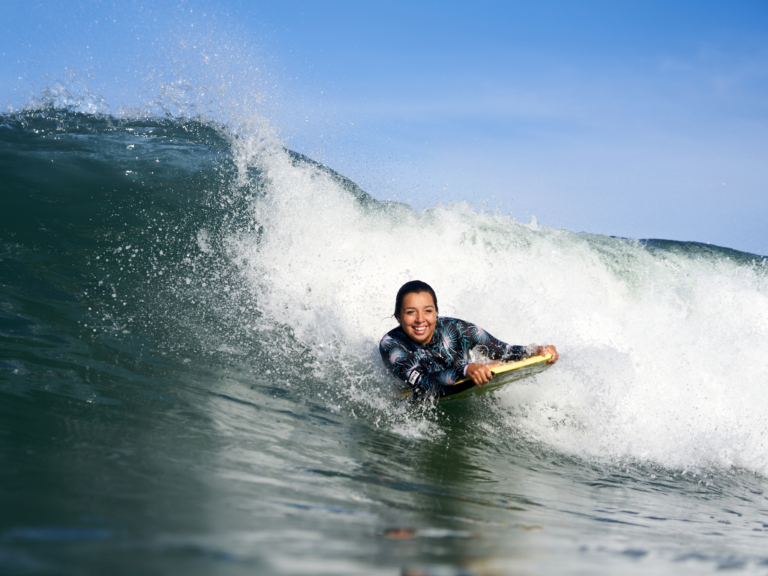
Sporting nothing but a bodyboard and good vibes, Sophie is part of the Native Like Water team and helped organize the trip.
“Looking back at that realization, I think about what we see in sea turtles,” says Marc. “In this area, we see sea turtles by the thousands—coming ashore, laying eggs, and new turtles hatching and heading out to sea. These turtles are born with this sense of where their home is, and even after traveling thousands of miles across the ocean, they’re drawn to return, and they can sense the way back. Before I even knew that my grandmother had lived here along this coast, intuition had led me back to the exact same place. The significance of that has taken a while to sink in, and I think it’s still sinking in.”
In front of Marc’s favorite wave along his ancestral coast, a group of about 12 people have gathered under a palapa to share some quesadillas with handmade blue corn tortillas—pressed by David’s mom, no less—before heading out for the midday session. While the retreat is open to all people, most attendees here today are of various Indigenous backgrounds. Palomx is a recording artist of Mixtec descent who connected with Native Like Water through social media and came to the retreat to start mending her relationship with the ocean after a traumatic childhood experience in the surf. Ricky Medina and his son Andres are San Diego surfers of Yaqui descent who came to share waves with each other, as well as to share their deep knowledge of Indigenous cultural practices with the group. Reg traveled to Mexico with his dad, Mark, who is not a surfer himself, but beams with pride every time his son leans into a smooth forehand carve.
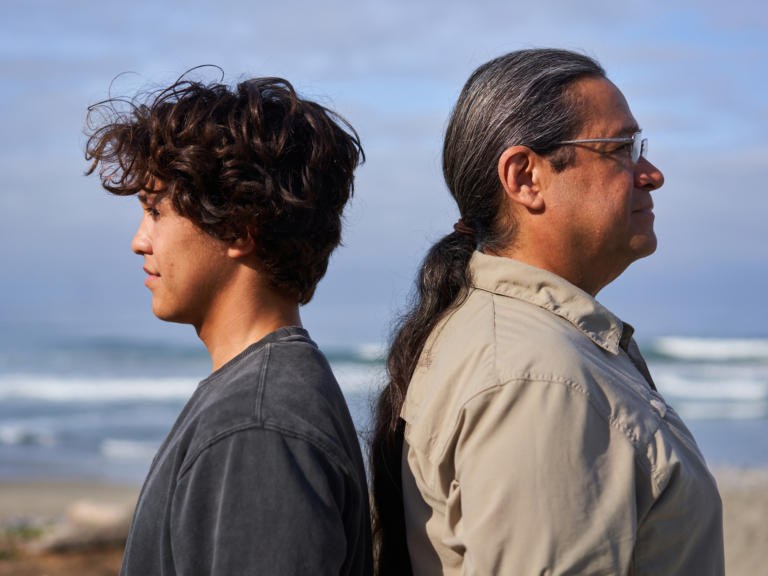
Reg and his pops, Mark, with the father-son profile view.
“I’m really happy that he has this opportunity to enjoy surfing,” says Mark, who grew up in Colton, California, before moving to Santa Barbara to attend the University of California, Santa Barbara, eventually settling in Temecula, where he serves as the Tribal Chairman of the Pechanga Band of Luiseño Indians. “I don’t feel that the opportunity was necessarily there for me when I was his age. The surf culture was completely different—it was white dominated in Southern California. There were surf punks and surf nazis, and it was ‘locals only.’ It didn’t just refer to people from that neighborhood, but I think it also had a racist bend to it. There was nothing inviting about it, so I chose to focus my energies somewhere else. I don’t know exactly when the world changed in surfing and opened up like this, but I’m just glad it did, and that organizations like Native Like Water are out here making connections between people.”
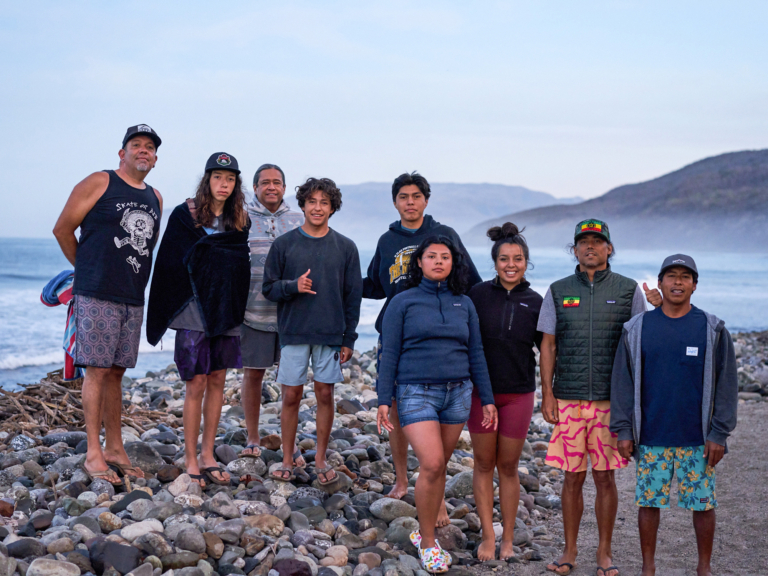
From left to right: Ricky and his son Andres, Mark and his son Reg, Coby, Palomx, Sophie, Marc and David.
The baggage of surf culture’s recent past doesn’t seem to weigh on his son Reg. One of the youngest at the retreat with only a few years of surfing under his belt, Reg is relishing every moment in the water—he’s the first one in, the last one out and clearly isn’t there to just enjoy the ocean; he’s also there to push himself to take off a little deeper and turn a little harder with each session. When he does pause to think about the historical context of Indigenous people in the ocean, he doesn’t feel bogged down by it—he feels inspired by surfing’s deeper past.
“When I first started surfing, I’d watch a lot of videos about where surfing came from, and it was super interesting learning about how it all came from Indigenous people. There’s this whole other side to surfing beyond just being out in the water and having fun—and knowing that history makes me feel more connected to who I am when I’m in the water.”
While Reg and Mark belong to the Pechanga Band of Indians, whose reservation is about 45 minutes from the coast, the broader Payómkawichum nations are seafaring people, whose traditional territory included the broad stretch of coast from modern-day San Onofre down to Cardiff, California. Mark remembers taking Reg to these beaches when he was younger and teaching him words like paala (water), móomat (ocean) and anoomal (porpoise, or little coyote). “We don’t just have this vocabulary for academic purposes,” he says. “It’s part of our cultural fabric.”
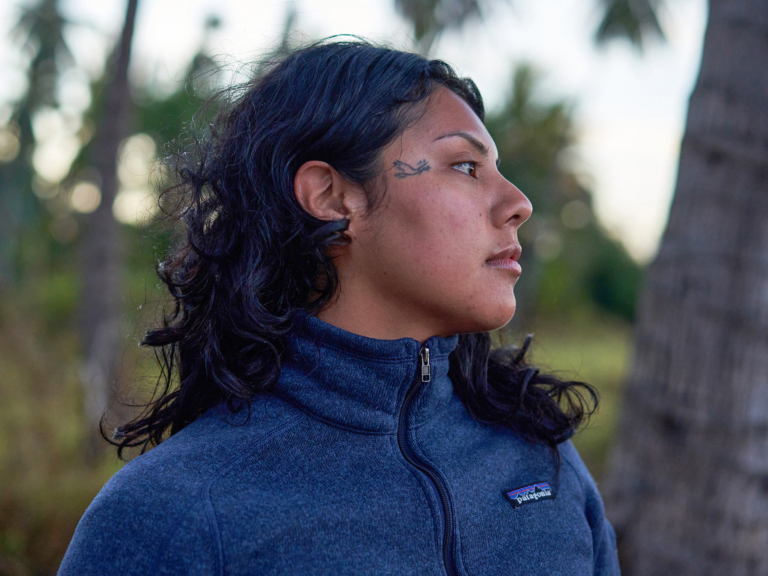
Palomx is a recording artist who lives in California’s Bay Area and came down for the retreat. She sings and raps in multiple languages, including Indigenous languages.
For many Indigenous peoples of North America, water is not only the key to life but also a profound shaper of culture. It frequently shows up in creation stories, songs and ceremonies. Their relationship to water often defines their traditions for eating, playing and praying. Here in Michoacán, we’re doing a bit of all three.
A few hours after our session at the left point, we’re back in the sleepy beach town, standing in a wide yard just above the beach where a stiff sideshore breeze has kicked up. The wind is bad for the waves, but good for the fire that’s swirling in the shallow pit next to a large concrete-and-rock dome called a temazcalli in Nahuatl. Three of Marc’s friends from Guadalajara are here to lead us in a Lakota-style sweat lodge ceremony, and they’ve stacked large stones among the burning logs.

Sweat and cleansing happens here.
Gonzalo, the leader of the ceremony, passes around a sack of tobacco, from which we each take a pinch and offer it to the fire as we speak our fathers’ and grandfathers’ names, and our intentions for the ceremony.
We crawl into the temazcalli and sit around its walls facing the center. Gonzalo’s friend hauls in the first batch of stones before sealing the door behind him. In the dark, the stones take on a different character entirely, glowing bright orange like orbs of lava stacked on top of one another.
Gonzalo explains that this place is the womb of Mother Earth, a point of connection between earthly and spirit worlds. He asks us to say the names of our mothers and grandmothers, then leads us through a series of prayers and songs punctuated by the loud hiss of the rocks as he douses them with water, sending potent waves of heat throughout the dome. Together, the heat, the steam, the sounds and the guiding of intentions places us all in a deeply meditative state. My mind is calm and quiet.
I was curious about the ceremony. While local Indigenous people have practiced sweat lodge ceremonies in this area for thousands of years, this one was done in the tradition of the Lakota people, whose territory lies several thousand miles away. Every Indigenous culture in North America is unique, but the retreat felt like an interweaving of songs in different languages and cultural practices developed in disparate locales. I wondered how Native people think about cultural exchange between Indigenous groups, while preserving their own unique identities.
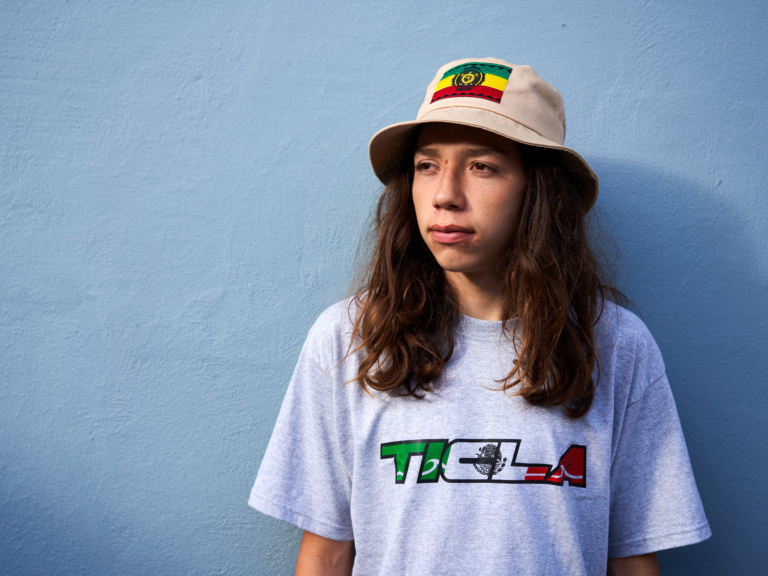
Ricky’s son Andres is a San Diego surfer of Chicano-Yaqui descent.
“I think it’s important to remember that Indigeneity can be powerfully complex and even messy. For me, Indigeneity is about how you live with the land and the culture you are immersed in daily,” Ricky tells me. Ricky is a Chicano-Yaqui Indigenous person who grew up in traditional Kumeyaay territory and was mentored by Chicano-Mexica teachers and Kumeyaay Elders who also practiced many Lakota traditions. It’s through these people that he was first introduced to sweat lodge ceremonies, which he’s now practiced for decades. “You have to realize that due to colonialism and specifically diaspora, a lot of us have lost our ability to clearly articulate where our families are from. That’s part of the legacy of colonialism—the main purpose of colonialism was to disconnect Indigenous people from their land and to erase their identity.
“One common thread through a lot of these Indigenous cultural traditions, though, is this concept of relationality,” Ricky continues. “There’s a part of the sweat [ceremony] when we say, mitakuye oyasin, that means, ‘to all my relations.’ We’re all connected to each other, and we’re all connected to the land. I think Native Like Water represents all of that.”
After more than an hour in the lodge, we crawl out into the light. Despite being coated in sweat and sand, there’s a lot of hugging all around, and I feel like I’ll leave this place feeling lighter, and not just from the profuse sweating. What happens next isn’t technically part of the ceremony, but it certainly feels like an appropriate extension of it: We all make our way down to the tide line, wade into the water and start to swim.
